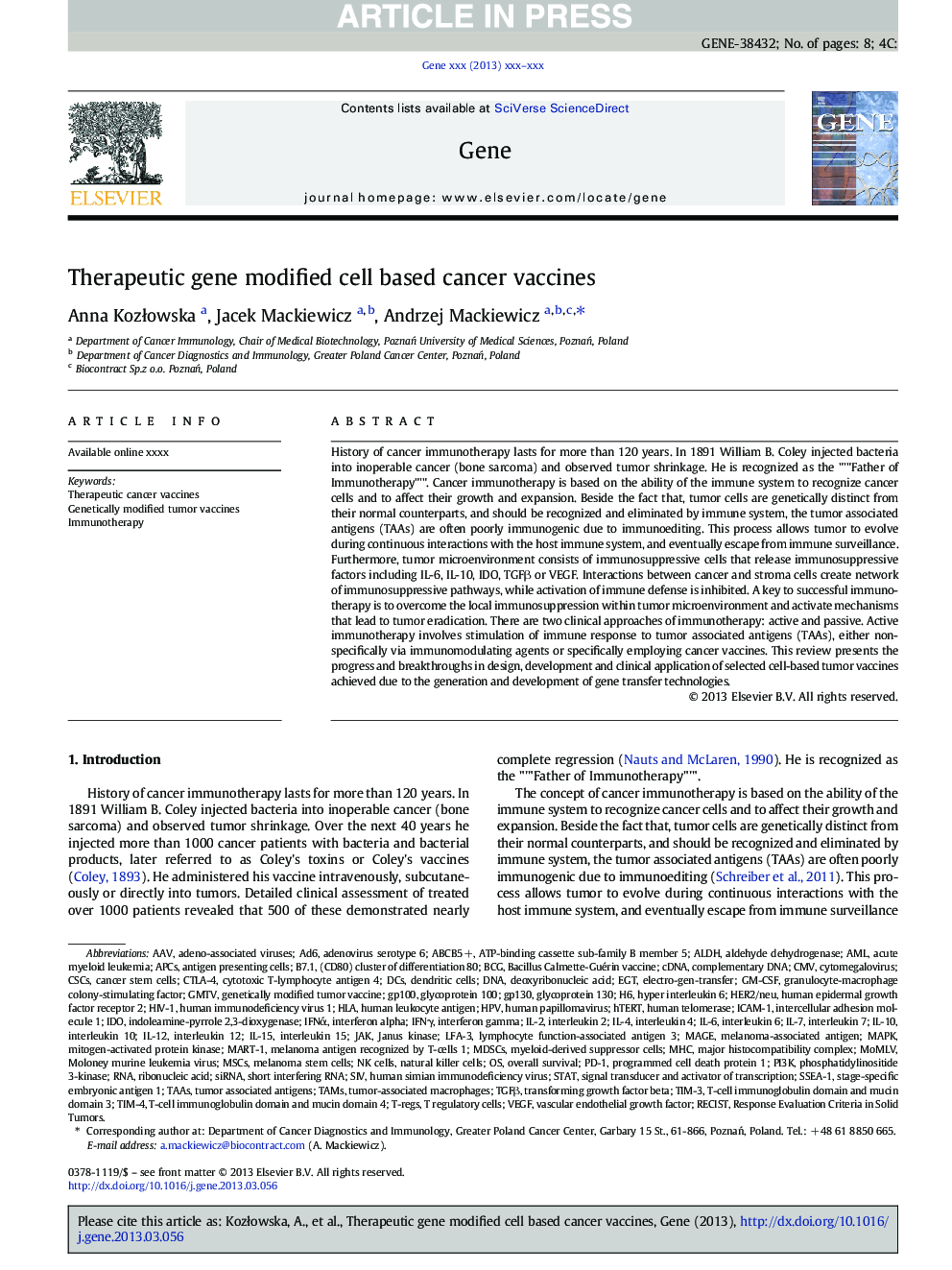| Article ID | Journal | Published Year | Pages | File Type |
|---|---|---|---|---|
| 5906204 | Gene | 2013 | 8 Pages |
Abstract
History of cancer immunotherapy lasts for more than 120 years. In 1891 William B. Coley injected bacteria into inoperable cancer (bone sarcoma) and observed tumor shrinkage. He is recognized as the "'"Father of Immunotherapy"'". Cancer immunotherapy is based on the ability of the immune system to recognize cancer cells and to affect their growth and expansion. Beside the fact that, tumor cells are genetically distinct from their normal counterparts, and should be recognized and eliminated by immune system, the tumor associated antigens (TAAs) are often poorly immunogenic due to immunoediting. This process allows tumor to evolve during continuous interactions with the host immune system, and eventually escape from immune surveillance. Furthermore, tumor microenvironment consists of immunosuppressive cells that release immunosuppressive factors including IL-6, IL-10, IDO, TGFβ or VEGF. Interactions between cancer and stroma cells create network of immunosuppressive pathways, while activation of immune defense is inhibited. A key to successful immunotherapy is to overcome the local immunosuppression within tumor microenvironment and activate mechanisms that lead to tumor eradication. There are two clinical approaches of immunotherapy: active and passive. Active immunotherapy involves stimulation of immune response to tumor associated antigens (TAAs), either non-specifically via immunomodulating agents or specifically employing cancer vaccines. This review presents the progress and breakthroughs in design, development and clinical application of selected cell-based tumor vaccines achieved due to the generation and development of gene transfer technologies.
Keywords
ALDHPI3KIL-6PD-1IL-15MSCsAPCsMAGEIL-4CSCsBCGICAM-1TGFβIL-10IL-2AAVDCsGM-CSFIDOIFNγgp130MDSCsSIVTIM-4IL-12IFNαIL-7MART-1EGTTAMsgp100indoleamine-pyrrole 2,3-dioxygenaseMoMLVB7.1SSEA-1AMLCTLA-4Bacillus Calmette-Guérin vaccineLFA-3T-regsJanus kinasecDNAComplementary DNADNAhTERTMAPKshort interfering RNAsiRNAaldehyde dehydrogenaseSTATcytotoxic T-lymphocyte antigen 4Human leukocyte antigenMelanoma-associated antigentumor associated antigensAntigen presenting cellsHLAdeoxyribonucleic acidRNAribonucleic acidimmunotherapyinterferon alphaInterleukin 10interleukin 12Interleukin 15interleukin 2Interleukin 4interleukin 6Interleukin 7HER2/neuoverall survivalTransforming Growth Factor BetaHuman telomeraseTim-3RECISTTAAsT regulatory cellsDendritic cellsMyeloid-derived suppressor cellsNK cellsNatural killer cellsCancer stem cellsCMVcytomegalovirusgranulocyte-macrophage colony-stimulating factorVascular endothelial growth factorVascular Endothelial Growth Factor (VEGF)phosphatidylinositide 3-kinaseacute myeloid leukemiaTumor-associated macrophagesSignal transducer and activator of transcriptionMHCmajor histocompatibility complexResponse Evaluation Criteria in Solid TumorsIntercellular adhesion molecule 1HIV-1Moloney murine leukemia virushuman immunodeficiency virus 1Adeno-associated virusesHuman papillomavirusHPVprogrammed cell death protein 1mitogen-activated protein kinaseJAKInterferon gammaglycoprotein 100glycoprotein 130Human epidermal growth factor receptor 2
Related Topics
Life Sciences
Biochemistry, Genetics and Molecular Biology
Genetics
Authors
Anna KozÅowska, Jacek Mackiewicz, Andrzej Mackiewicz,
